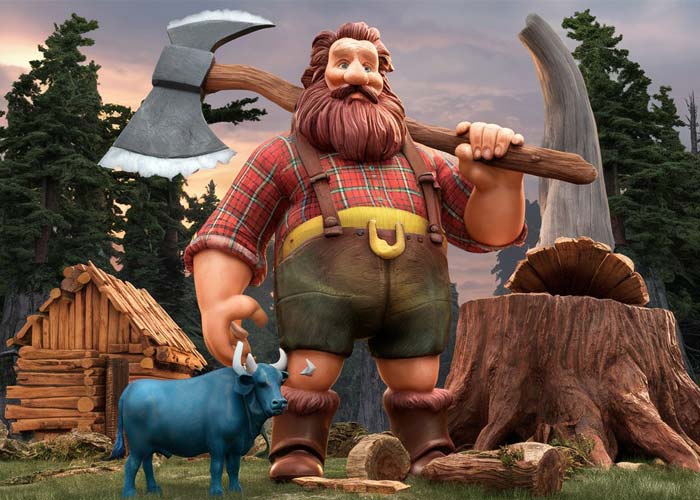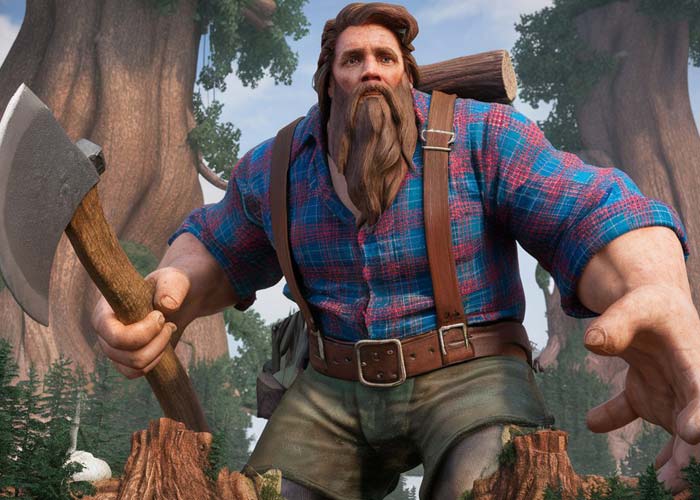
The exact origins of Paul Bunyan are unclear, but his stories are believed to have originated among lumberjacks in the northern United States and Canada in the late 19th and early 20th centuries.
As logging camps moved across the country, so did the tales of Paul Bunyan, growing more outlandish and exaggerated with each retelling.
His was born in a logging camp in Maine, and he was so big that he weighed 12 pounds at birth.
Paul Bunyan’s birth was an event of epic proportions, heralded by a thunderclap that shook the very foundations of the logging camp where his mother resided.
Paul Bunyan’s Appearance and Personality

Paul Bunyan was said to be a giant of a man, standing over 50 feet tall and weighing over 500 pounds.
He had a hearty appetite, consuming massive quantities of food and drink.
Paul Bunyan was also known for his kindness and generosity, always willing to help those in need.
As Paul grew, so did his growth and strength.
By the time he reached his teens, he towered over every man in the camp, his body as sturdy as an ancient oak tree.
His hands, which were as big as dinner plates, could grip an ax with the strength of a thousand men, and his laughter could rumble like distant thunder.
Babe the Blue Ox Appearance and Personality
Appearance
Babe the Blue Ox, Paul Bunyan’s loyal friend, is a magnificent giant creature.
Born from a bolt of lightning striking a field of wildflowers, Babe possesses incredible strength and unwavering loyalty.
He was taller than a two-story house, and he could carry logs as easily as a child carrying toys. Its powerful bellows can shake mountains.
Babe’s fur color is bright blue, like a clear night sky.
Her eyes were large and filled with intelligence, and her large nose was pink.
His wide, floppy ears were always twitching, listening for Paul’s commands or the sounds of the forest around him.
Babe’s feet are large and sturdy, with strong hooves that can grip steep ground with ease.
Its long, thick tail acts as a rudder, helping it maneuver through dense forests.
Personality
Babe has a friendly and loyal personality.
He is always happy to help Paul with any task, and he is always there for him when he needs a friend.
Babe is also very smart and likes learning new things.
He was always curious about the world around him, and he always sought to understand the humans he worked with.
Babe is a cheerful and optimistic creature.
He always sees the good side of every situation, and he always has a kind word to say.
He was also very funny, and he often made Paul and others laugh with his jokes and stories.
Even though Babe is a giant creature, he has a big and gentle heart.
He always cared about others, and he always tried to help those in need.
He is a true and loyal friend, and he will always be there for Paul, no matter what.
Babe the Blue Ox: A Loyal Companion
Paul’s companion, Babe the Blue Ox, was as extraordinary as he was.
Born from a bolt of lightning that struck a field of wildflowers, Babe was a magnificent creature of immense strength and unwavering loyalty.
Standing taller than a two-story house, Babe could haul logs with the ease of a child carrying a toy, and his bellow could shake the mountains.
Together, Paul and Babe formed an unstoppable duo, their combined strength and determination conquering any challenge that stood in their path.
They felled trees with the speed of lightning, cleared forests with a single swing of Paul’s axe, and built dams that tamed the wildest rivers.
The Popular Story of Paul Bunyan and Babe the Blue Ox
In the heart of the American wilderness, among towering pines and vast forests, there once lived a man of giant stature and legendary strength – Paul Bunyan.
His name echoes through the ages, whispered in awe by loggers and settlers alike, serving as a living testament to his extraordinary prowess and the indelible mark he left on the American landscape.
Paul Bunyan’s achievements became the stuff of legend, passed down from generation to generation, each story more majestic and full of awe than the last.
They tell how Paul dug up the Great Lakes with a single sweep of his axe, created the Grand Canyon in a burst of fury, and even wrestled a tornado to the ground.
One of the most beloved stories tells how Paul and Babe were tasked with clearing a dense forest for a new town.
Paul Bunyan: Well, Babe, looks like we’ve got ourselves quite the job ahead.
Babe the Blue Ox: Indeed, Paul. This forest is thicker than the fur on a bear in winter.
Paul Bunyan: But you know what they say, Babe, no job is too big for us!
Babe the Blue Ox: That’s right, Paul. We’ll have this forest cleared faster than you can say “timber”!
Paul Bunyan: Ha! You always know how to lighten the mood, Babe. But seriously, we need to be careful. We don’t want to upset the balance of nature.
Babe the Blue Ox: Agreed, Paul. Let’s make sure to only take what we need and leave the rest for the critters.
Paul Bunyan: Couldn’t have said it better myself, Babe. Alright, let’s get to work. The sooner we start, the sooner this town can start flourishing.
Babe the Blue Ox: You got it, Paul. With your strength and my determination, there’s nothing we can’t accomplish!
Paul Bunyan: That’s the spirit, Babe. Let’s show this forest who’s boss!
they worked tirelessly, they cleared the entire forest in one day, only to find that it had grown back overnight.
Enraged, Paul took the entire forest and threw it into the Atlantic Ocean, creating Newfoundland in the process.
As the morning sun began to paint the sky gold and crimson, Paul Bunyan stretched his massive frame, his joints creaking like gunfire. With a yawn that could rattle the windows, he rose from his bed, a giant redwood log hollowed out to accommodate his enormous size.
“Well, Babe,” he thundered, greeting his faithful companion, “another day awaits us. Let’s get started!”
Babe, always eager to please his master, let out a mighty howl that shook the trees and sent birds scattering in all directions.
Together, Paul and Babe head into the wilderness, their footprints leaving deep marks in the ground.
As they ventured deeper into the forest, the towering pines seemed to bow in reverence before their giant forms.
Paul’s axe, a mighty weapon forged from the finest steel, glinted in the sun, ready to tackle any task.
With a mighty swing, Paul brought his ax down on a towering oak tree, the sound echoing through the valley like thunder.
The tree shook, its branches swaying dangerously before finally giving way, falling to the ground with a deafening thud.
Meanwhile, Babe is busy hauling logs, his huge hooves digging deep furrows into the forest floor.
With each charge, he let out a triumphant howl, his breath creating clouds of steam that rose into the air.
As the days passed, Paul and Babe worked tirelessly, their strength and determination unwavering.
They cleared forests, built roads, and even dammed rivers, their engineering skills transforming wilderness into habitable landscapes.
The origins of Paul Bunyan
The origins of Paul Bunyan are shrouded in a mix of fact and folklore, making it difficult to pinpoint a single definitive source.
Here’s what we know about the possible roots of this legendary figure:
1. Oral Tradition of Lumberjacks:
- Most researchers agree that Paul Bunyan originated from the tall tales and exaggerations shared by lumberjacks in North America during the 19th and early 20th centuries.
- These hard-working men, isolated in logging camps, entertained themselves by spinning yarns of larger-than-life figures with superhuman strength and abilities.
- Over time, these stories likely coalesced into the central figure of Paul Bunyan.
2. Possible Real-Life Inspiration:
- Some suggest that Paul Bunyan may have been loosely inspired by real-life lumberjacks known for their size and strength. Possible contenders include:
- Fabian Fournier, a French-Canadian logger renowned for his height and power.
- Angus “Giant” MacAskill, a Nova Scotian giant known for his feats of strength.
3. Early Print Publications:
- In 1910, writer James MacGillivray published a short article containing humorous stories about a giant logger named Paul Bunyan. This is considered one of the earliest written references to the character.
- In 1916, an advertising pamphlet for the Red River Lumber Company featured further tales of Paul Bunyan, solidifying his presence in popular culture.
4. Evolution and Embellishment:
- As stories of Paul Bunyan spread, they were embellished and exaggerated. New tales were added, increasing the scope of his legendary feats.
- Writers, artists, and advertisers all embraced Paul Bunyan as a symbol of American strength, ingenuity, and the spirit of frontier expansion.
In Summary
The origins of Paul Bunyan are a fascinating blend of:
- Oral tradition: Tall tales and exaggerations passed down through generations of lumberjacks.
- Possible real-life inspiration: Drawn from actual lumberjacks who were larger than life.
- Early print publications: Short stories and advertising pamphlets that popularized the character.
- Continuous embellishment: Adding to the legend with increasingly outlandish tales and attributes.
Paul Bunyan embodies the spirit and mythology of the American lumberjack, making it a timeless and iconic character of American folklore.
Another Paul Bunyan story
- Paul Bunyan in California: Retellings of Paul Bunyan’s famous California stories, such as digging San Francisco Bay and building the Golden Gate Bridge.
- Paul Bunyan in Minnesota: Uncover the legend of Paul Bunyan in Minnesota, such as recreating Lake Superior and building Paul Bunyan’s Cabin.
- Paul Bunyan in North Dakota: Discover the mystery behind the famous Paul Bunyan statue in Fargo, North Dakota.
- Paul Bunyan in Maine: Following in the footsteps of Paul Bunyan in Acadia National Park and the Kennebec River, Maine.
- Paul Bunyan in Oregon: Exploring the legend of Paul Bunyan at Mount Hood and the Columbia River Gorge, Oregon.
